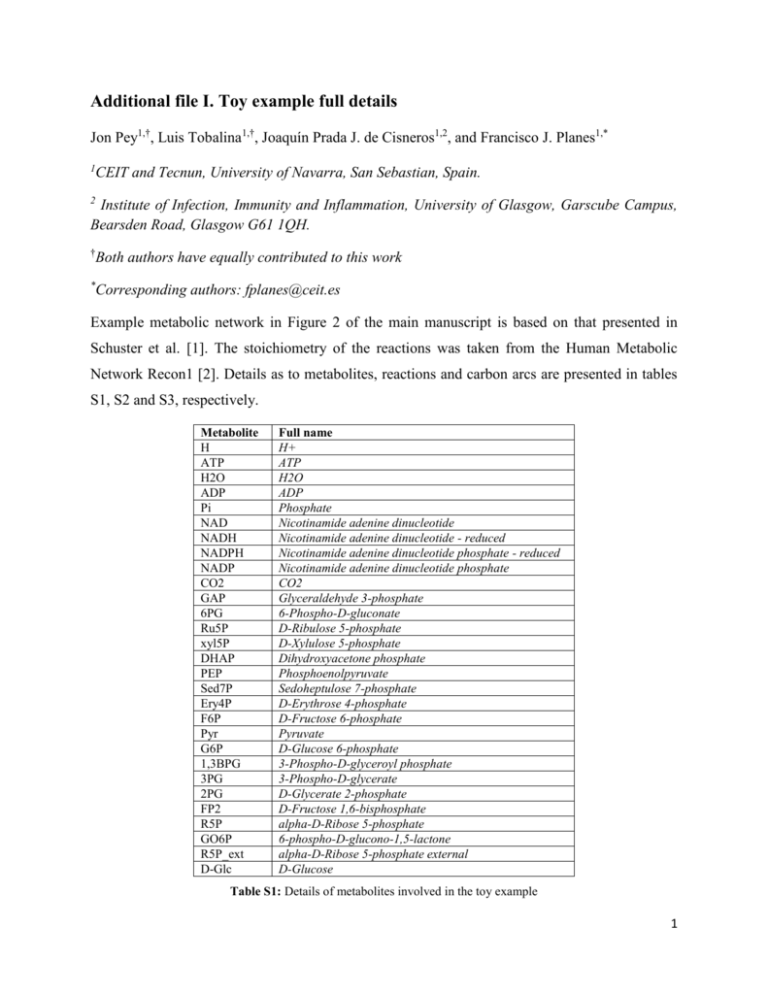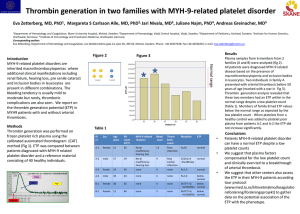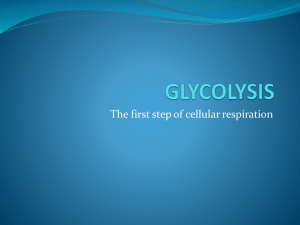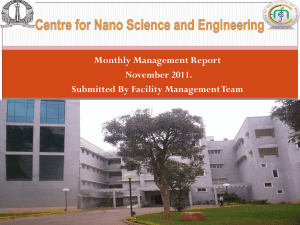file - BioMed Central
advertisement

Additional file I. Toy example full details Jon Pey1,†, Luis Tobalina1,†, Joaquín Prada J. de Cisneros1,2, and Francisco J. Planes1,* 1 CEIT and Tecnun, University of Navarra, San Sebastian, Spain. 2 Institute of Infection, Immunity and Inflammation, University of Glasgow, Garscube Campus, Bearsden Road, Glasgow G61 1QH. † Both authors have equally contributed to this work * Corresponding authors: fplanes@ceit.es Example metabolic network in Figure 2 of the main manuscript is based on that presented in Schuster et al. [1]. The stoichiometry of the reactions was taken from the Human Metabolic Network Recon1 [2]. Details as to metabolites, reactions and carbon arcs are presented in tables S1, S2 and S3, respectively. Metabolite H ATP H2O ADP Pi NAD NADH NADPH NADP CO2 GAP 6PG Ru5P xyl5P DHAP PEP Sed7P Ery4P F6P Pyr G6P 1,3BPG 3PG 2PG FP2 R5P GO6P R5P_ext D-Glc Full name H+ ATP H2O ADP Phosphate Nicotinamide adenine dinucleotide Nicotinamide adenine dinucleotide - reduced Nicotinamide adenine dinucleotide phosphate - reduced Nicotinamide adenine dinucleotide phosphate CO2 Glyceraldehyde 3-phosphate 6-Phospho-D-gluconate D-Ribulose 5-phosphate D-Xylulose 5-phosphate Dihydroxyacetone phosphate Phosphoenolpyruvate Sedoheptulose 7-phosphate D-Erythrose 4-phosphate D-Fructose 6-phosphate Pyruvate D-Glucose 6-phosphate 3-Phospho-D-glyceroyl phosphate 3-Phospho-D-glycerate D-Glycerate 2-phosphate D-Fructose 1,6-bisphosphate alpha-D-Ribose 5-phosphate 6-phospho-D-glucono-1,5-lactone alpha-D-Ribose 5-phosphate external D-Glucose Table S1: Details of metabolites involved in the toy example 1 Reaction Gnd Tal Pgi Gap Pfk Eno Fbp TpiA TktII Gpm TktI Pgk Rpe Rpi Zwf Fba Pyk Pgl EX_r5p Hex1 Full name phosphogluconate dehydrogenase transaldolase glucose-6-phosphate isomerase glyceraldehyde-3-phosphate dehydrogenase phosphofructokinase Enolase fructose-bisphosphatase triose-phosphate isomerase transketolase phosphoglycerate mutase transketolase phosphoglycerate kinase ribulose 5-phosphate 3-epimerase ribose-5-phosphate isomerase glucose 6-phosphate dehydrogenase fructose-bisphosphate aldolase pyruvate kinase 6-phosphogluconolactonase hexokinase (D-glucose:ATP) Formula 6PG + NADP --> CO2 + NADPH + Ru5P GAP + Sed7P <==> Ery4P + F6P G6P <==> F6P GAP + NAD + Pi <==> 1,3BPG + H + NADH ATP + F6P --> ADP + FP2 + H 2PG <==> H2O + PEP FP2 + H2O --> F6P + Pi DHAP <==> GAP Ery4P + Xyl5P <==> F6P + GAP 2PG <==> 3PG R5P + Xyl5P <==> GAP + Sed7P 3PG + ATP <==> 1,3BPG + ADP Ru5P <==> Xyl5P R5P <==> Ru5P G6P + NADP <==> GO6P + H + NADPH FP2 <==> DHAP + GAP ADP + H + PEP --> ATP + Pyr GO6P + H2O --> 6PG + H R5P --> R5P_ext ATP + D-Glc --> ADP + G6P + H Table S2: Details of reactions involved in the toy example Source NADP 6PG GAP Sed7P Sed7P G6P NAD GAP F6P 2PG FP2 DHAP xyl5P xyl5P Ery4P 2PG xyl5P xyl5P R5P 3PG Ru5P R5P NADP G6P FP2 FP2 PEP GO6P Target NADPH Ru5P F6P Ery4P F6P F6P NADH 1,3BPG FP2 PEP F6P GAP GAP F6P F6P 3PG GAP Sed7P Sed7P 1,3BPG xyl5P Ru5P NADPH GO6P GAP DHAP Pyr 6PG Reaction Gnd Gnd Tal Tal Tal Pgi Gap Gap Pfk Eno Fbp TpiA TktII TktII TktII Gpm TktI TktI TktI Pgk Rpe Rpi Zwf Zwf Fba Fba Pyk Pgl 2 R5P D-Glc R5P[e] G6P Prs_DeoB Hex1 Table S3: Details of carbon arcs involved in the toy example For convenience, we also added exchange reactions to the list of metabolites in Table S4. In the work of Schuster et al. [1] these metabolites were considered external metabolites. Metabolite H ATP H2O ADP Pi NAD NADH NADPH NADP CO2 Pyr D-Glc R5P_ext Full name H+ ATP H2O ADP Phosphate Nicotinamide adenine dinucleotide Nicotinamide adenine dinucleotide - reduced Nicotinamide adenine dinucleotide phosphate - reduced Nicotinamide adenine dinucleotide phosphate CO2 Pyruvate D-Glucose alpha-D-Ribose 5-phosphate external Table S4: Additional exchange reactions in the toy example We assumed that Glucose-6-Phosphate (G6P) is identified in high concentration and therefore enzymes responsible for its accumulation are evaluated. As noted in the main paper, we search for enzymes whose knockout increase distances of degradation pathways of G6P and may therefore explain such accumulation. Aiming at guaranteeing an effective consumption of G6P and avoid recirculation via cyclic pathways when balancing the path, we added an exchange reaction for the metabolite under study (here G6P). In order to force this reaction, we included an artificial metabolite as substrate of this reaction, in our case G6P[a], as observed in Figure S1. Overall, we added the following reaction: G6P[a]G6P, which logically involves a carbon arc exchange. Clearly, stoichiometric balance is not applied to the artificial metabolite. Finding paths from G6P[a] (instead of G6P) to the rest of metabolites guarantees effective consumption of G6P. In terms of CFP distances, this step is not taken into account. For this reason we remove this step from resulting CFPs, as observed below. We provide below resulting CFPs in the different scenarios discussed in the main manuscript. Finally, note that this technical detail was also used in the analysis of Lcystin and Hcys. 3 Figure S1: Example metabolic network including artificial reaction exchange for G6P 4 CFPs obtained in Wild-Type: G6P --> F6P --> GAP G6P --> GO6P --> 6PG G6P --> F6P --> xyl5P --> Ru5P G6P --> F6P --> xyl5P G6P --> F6P --> FP2 --> DHAP G6P --> F6P --> GAP --> 1,3BPG --> 3PG --> 2PG --> PEP G6P --> F6P --> Sed7P G6P --> F6P --> Ery4P G6P --> F6P G6P --> F6P --> GAP --> 1,3BPG --> 3PG --> 2PG --> PEP --> Pyr G6P --> F6P --> GAP --> 1,3BPG G6P --> F6P --> GAP --> 1,3BPG --> 3PG G6P --> F6P --> GAP --> 1,3BPG --> 3PG --> 2PG G6P --> F6P --> FP2 G6P --> F6P --> Sed7P --> R5P G6P --> GO6P G6P --> F6P --> Sed7P --> R5P --> R5P[e] 5 CFPs obtained with Pgi knocked-out: G6P --> GO6P --> 6PG --> Ru5P --> xyl5P --> GAP G6P --> GO6P --> 6PG G6P --> GO6P --> 6PG --> Ru5P G6P --> GO6P --> 6PG --> Ru5P --> xyl5P G6P --> GO6P --> 6PG --> Ru5P --> xyl5P --> F6P --> FP2 --> DHAP G6P --> GO6P --> 6PG --> Ru5P --> xyl5P --> GAP --> 1,3BPG --> 3PG --> 2PG --> PEP G6P --> GO6P --> 6PG --> Ru5P --> xyl5P --> Sed7P G6P --> GO6P --> 6PG --> Ru5P --> R5P --> Sed7P --> Ery4P G6P --> GO6P --> 6PG --> Ru5P --> xyl5P --> F6P G6P --> GO6P --> 6PG --> Ru5P --> xyl5P --> GAP --> 1,3BPG --> 3PG --> 2PG --> PEP --> Pyr G6P --> GO6P --> 6PG --> Ru5P --> xyl5P --> GAP --> 1,3BPG G6P --> GO6P --> 6PG --> Ru5P --> xyl5P --> GAP --> 1,3BPG --> 3PG G6P --> GO6P --> 6PG --> Ru5P --> xyl5P --> GAP --> 1,3BPG --> 3PG --> 2PG G6P --> GO6P --> 6PG --> Ru5P --> xyl5P --> F6P --> FP2 G6P --> GO6P --> 6PG --> Ru5P --> R5P G6P --> GO6P G6P --> GO6P --> 6PG --> Ru5P --> R5P --> R5P[e] 6 CFPs obtained with TpiA knocked-out: G6P --> GO6P --> 6PG --> Ru5P --> xyl5P --> GAP G6P --> GO6P --> 6PG G6P --> GO6P --> 6PG --> Ru5P G6P --> GO6P --> 6PG --> Ru5P --> xyl5P G6P --> GO6P --> 6PG --> Ru5P --> xyl5P --> GAP --> 1,3BPG --> 3PG --> 2PG --> PEP G6P --> GO6P --> 6PG --> Ru5P --> R5P --> Sed7P G6P --> GO6P --> 6PG --> Ru5P --> xyl5P --> Sed7P --> Ery4P G6P --> GO6P --> 6PG --> Ru5P --> xyl5P --> F6P G6P --> GO6P --> 6PG --> Ru5P --> xyl5P --> GAP --> 1,3BPG --> 3PG --> 2PG --> PEP --> Pyr G6P --> GO6P --> 6PG --> Ru5P --> xyl5P --> GAP --> 1,3BPG G6P --> GO6P --> 6PG --> Ru5P --> xyl5P --> GAP --> 1,3BPG --> 3PG G6P --> GO6P --> 6PG --> Ru5P --> xyl5P --> GAP --> 1,3BPG --> 3PG --> 2PG G6P --> GO6P --> 6PG --> Ru5P --> xyl5P --> F6P --> FP2 G6P --> GO6P --> 6PG --> Ru5P --> R5P G6P --> GO6P G6P --> GO6P --> 6PG --> Ru5P --> R5P --> R5P[e] 7 References 1. Schuster S, Fell DA, Dandekar T: A general definition of metabolic pathways useful for systematic organization and analysis of complex metabolic networks. Nat Biotech 2000, 18:326-332. 2. Duarte NC, Becker SA, Jamshidi N, Thiele I, Mo ML, Vo TD, Srivas R, Palsson BØ: Global reconstruction of the human metabolic network based on genomic and bibliomic data. Proceedings of the National Academy of Sciences 2007, 104:1777-1782. 8








